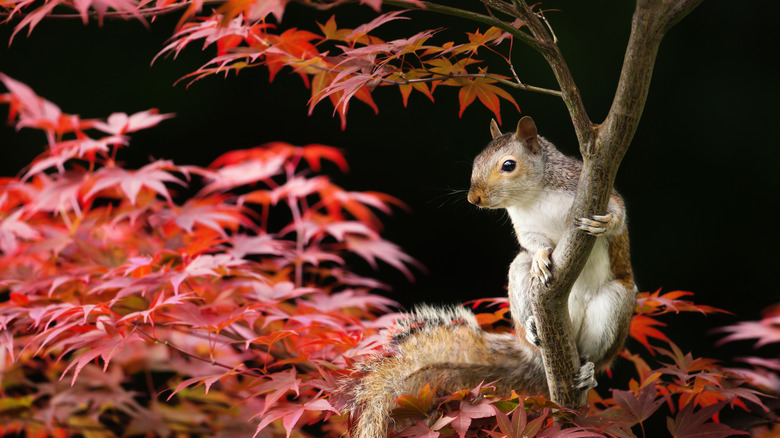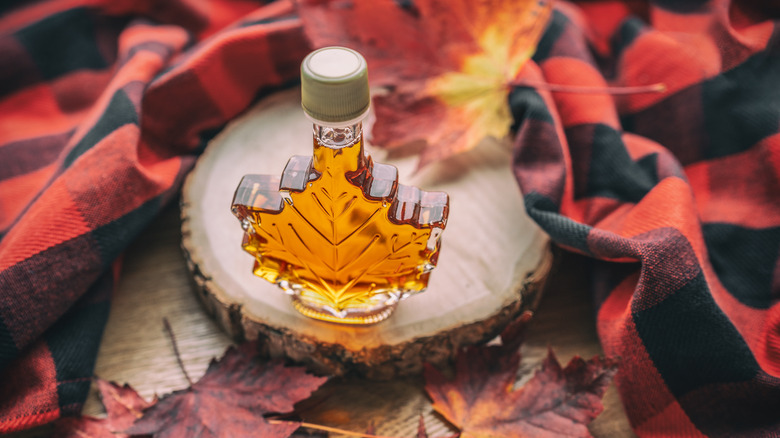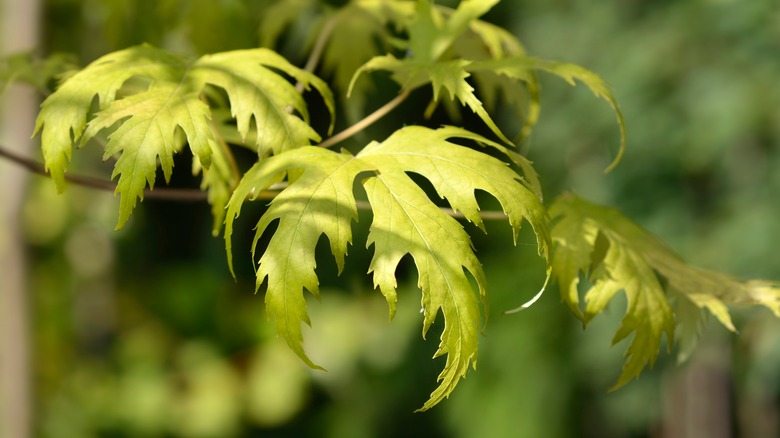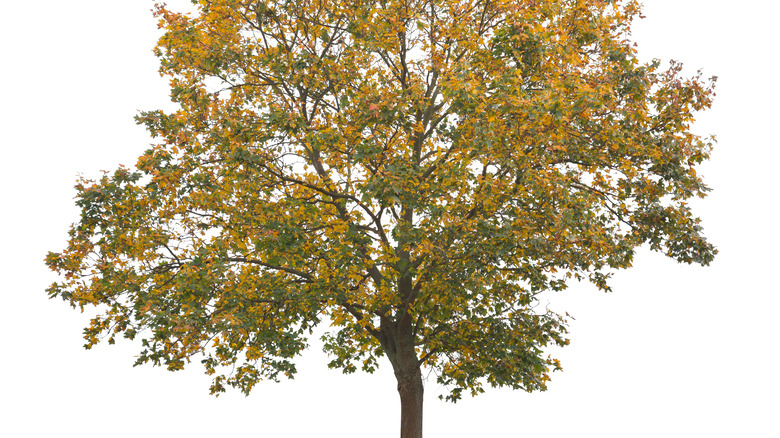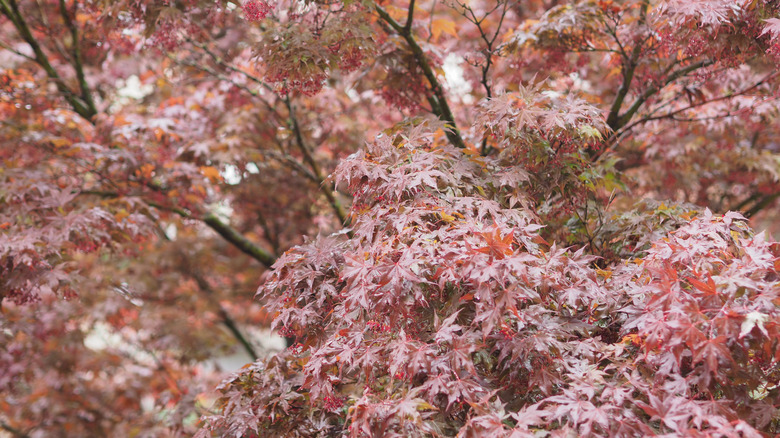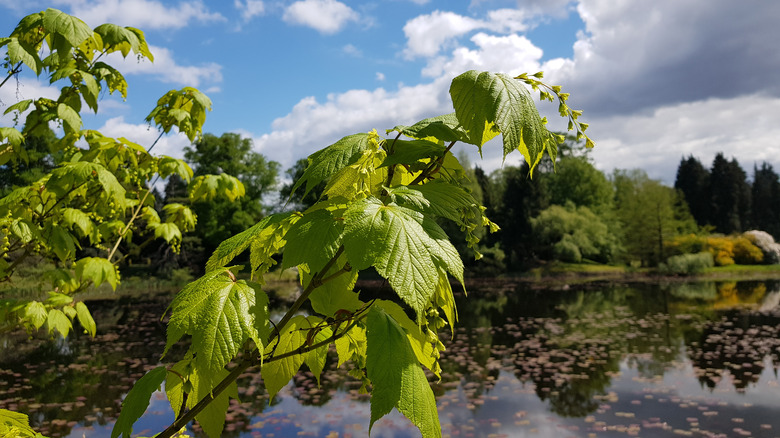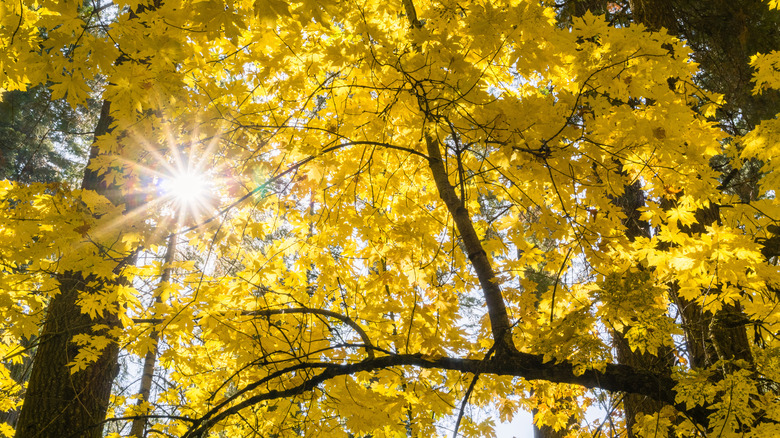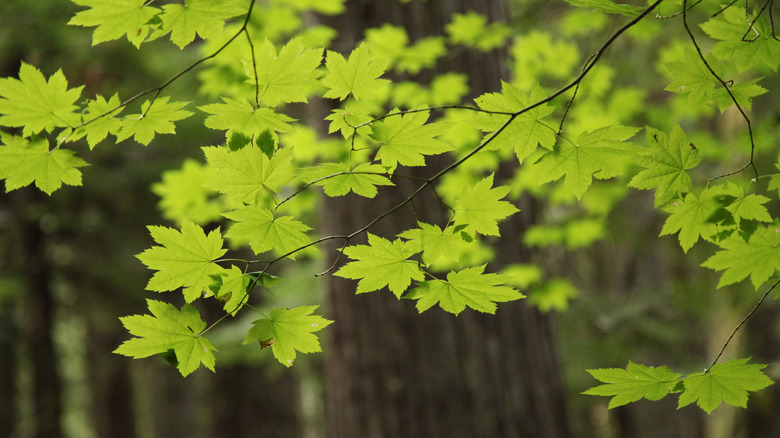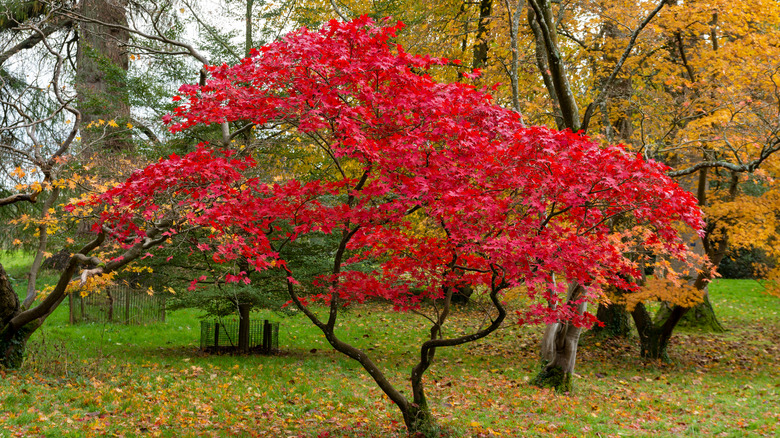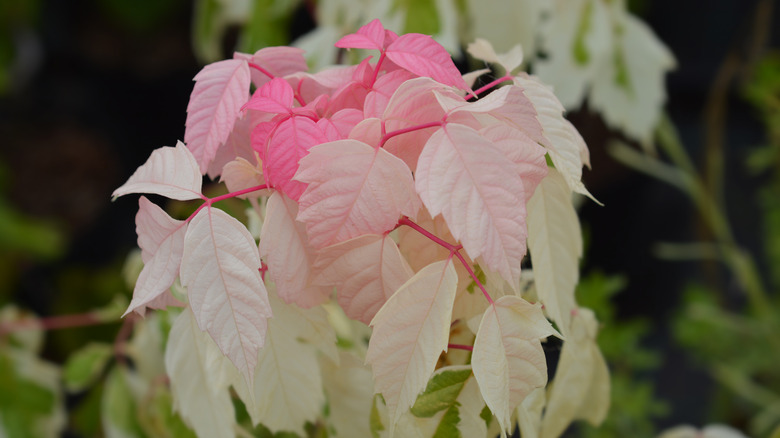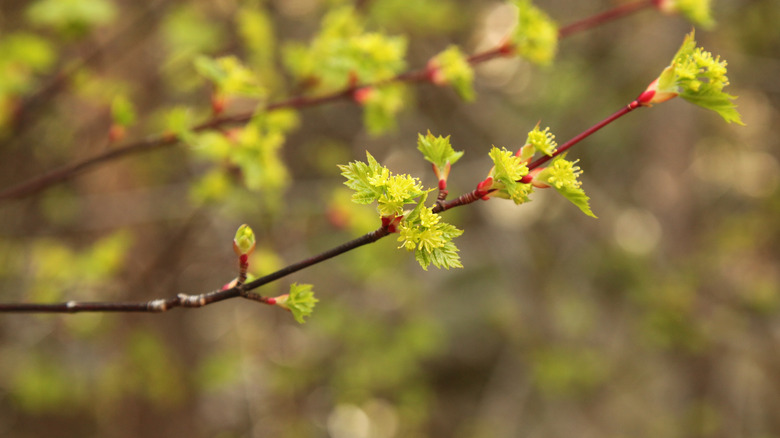10 Stunning Maple Trees That Will Add Drama To Your Yard
With maple trees come squirrels, birds, chipmunks, deer, elk, high and wide summertime shade canopies, dramatic splashes of color, and huge piles of raked leaves to jump into in the fall. Yes, adding this single tree to your landscape will bring tremendous visual appeal alongside a parade of dynamic and entertaining visitors. And if you're the homesteading type, most of them can be tapped for homegrown maple syrup.
Maple trees range widely in size with leaf and trunk variations, yet they are all absolutely gorgeous and look great in a yard. Per Garden Tabs, these trees do flower on a yearly basis in mid to late spring; however, their blossoms are quite insignificant and easy to miss. Since they are deciduous, they will lose their leaves as the temperatures drop late in the year.
The national tree of Canada is primarily known for its easily recognizable leaf shape and stunning changes of color come autumn. In fact, maple trees are one of the primary draws for leaf peepers who flood New England every fall in search of the brightest and most stunning foliage shows.
Some grow as understory trees beneath the canopies of old-growth forests. But most maples stretch very high into the sky and create those wide-spreading canopies themselves. Here are 10 varieties that will add some serious flair to your landscape.
1. Sugar maple
Per Practical Self Reliance, sugar maples (Acer saccahrum) are the go-to choice when it comes to tapping trees because they produce the syrup with the highest sugar content. Over a six-week sugaring season, one tree can yield a single quart of golden deliciousness. These sturdy, single-trunk, slow-growing trees can live for over 400 years.
Bloom Season: Spring
USDA Growing Zone: 3 to 8
Growing Conditions: Full to partial sun with a minimum of 4 hours of direct sunlight daily
Soil Type: Well-draining
Size: 60 to 75 feet tall, 40- to 50-foot canopy spread
2. Silver maple
Similar in botanic name to the sugar maple, though different in a few key ways, bplant.org explains that the silver maple (Acer saccharinum) is a fast grower with many slim trunks that grow out at an angle. It gets its common name from the silver-tinted color on the underside of its leaves.
Bloom Season: Spring
USDA Growing Zone: 3 to 9
Growing Conditions: Full to partial sun with a minimum of 4 hours of direct sunlight daily
Soil Type: Moist, acidic
Size: 50 to 80 feet tall, 35- to 50-foot canopy spread
3. Black maple
Black maple trees (Acer saccharum subsp. nigrum) are technically a subspecies of the sugar maple with darker bark and deeper hued leaves with three instead of five lobes. Tall with a single, sturdy trunk, black maple trees can grow as much as 100 feet tall (via Iowa State University Extension & Outreach).
Bloom Season: Spring
USDA Growing Zone: 4 to 8
Growing Conditions: Full to partial sun with a minimum of 4 hours of direct sunlight daily
Soil Type: Loam with high organic matter content, moist, well-draining
Size: 80 to 100 feet tall, 40- to 60-foot canopy spread
4. Red maple
Acer rubrum, the red maple, distinguishes itself from the others with its crimson leaves, twigs, flowers, and even seeds. The leaves only get more spectacularly bright as the season turns towards fall. The Morton Arboretum says red maple root systems are particularly dense and wide spreading.
Bloom Season: Spring
USDA Growing Zone: 3 to 9
Growing Conditions: Full to partial sun with a minimum of 4 hours of direct sunlight daily
Soil Type: Moist, well-draining, acidic
Size: 40 to 60 feet tall, 35- to 45-foot canopy spread
5. Striped maple
The bark of this variety gives it its common name of striped maple (Acer pensylvanicum). Striped maples are smaller than their family members, often reaching only 20 feet tall. In a forest setting, they grow slowly as understory trees sometimes ending up as small as a shrub. This offers vertical diversity particularly appreciated by the black-throated blue warblers who nest in them, per Adirondacks Forever Wild.
Bloom Season: Spring
USDA Growing Zone: 3 to 7
Growing Conditions: Shade to part shade
Soil Type: Well-draining, acidic
Size: 15 to 20 feet tall, 7- to 10-foot canopy spread
6. Bigleaf maple
One of the largest maple varieties, Acer macrophyllum, can grow to a staggering 115 feet tall (via Putah Creek Council). The Oregon maple is aptly nicknamed Bigleaf and is most commonly found on the west coast. It is a fast-growing tree adored for its sparkling golden canopy in the fall.
Bloom Season: Spring
USDA Growing Zone: 6 to 7
Growing Conditions: Full to partial sun with a minimum of 4 hours of direct sunlight daily
Soil Type: Moist, well-draining, acidic
Size: Up to 115 feet tall with a 65-foot canopy spread
7. Vine maple
The understory vine maple (Acer circinatum) is not a typical vining plant, but it does have rather thin branches that have a tendency to sprawl and individually take root. It is a very popular landscaping shrub in the Pacific Northwest (via Native Plants PNW). Deer and elk love to dine on this tree, so it's perhaps not the best choice if you're intent on keeping them out of your yard.
Bloom Season: Spring to early summer
USDA Growing Zone: 6 to 9
Growing Conditions: Full to partial sun
Soil Type: Clay, loam
Size: Up to 20 feet tall
8. Japanese maple
The delightful little Japanese maple (Acer palmatum) is the perfect ornamental addition to a front or side yard. It is an unassuming yet beautiful tree with vibrant red leaves throughout late spring and summer. Within the species, there are many cultivars to choose from, including at least 15 dwarf weeping varieties that will top out at around 5 feet tall.
Bloom Season: Spring
USDA Growing Zone: 5 to 8
Growing Conditions: Dapple sun filtered through a canopy above
Soil Type: Moist, well-draining, high organic content
Size: 15 to 20 feet tall, 10- to 25-foot canopy spread
9. Boxelder maple
If you have a water feature in your yard, consider planting a boxelder maple (Acer negundo), which will feel right at home when planted next to a stream or pond. The University of Minnesota Extension says it's a fast grower that can tolerate a range of soil conditions. The pink, cream, and green variegations of the 'Flamingo' cultivar put it in a class all its own.
Bloom Season: Spring
USDA Growing Zone: 2 to 9
Growing Conditions: Full to partial sun
Soil Type: Sandy loam, clay
Size: 30 to 65 tall with an equal canopy spread
10. Rocky Mountain maple
The Rocky Mountain maple (Acer glabrum) is considered a shrub more than a tree. It produces small fragrant flowers in the spring and its twigs maintain a reddish tint throughout the year. This maple grows farther north than the others and can be found in southeastern Alaska. The Lady Bird Johnson Wildflower Center says its species name, glabrum, translates to hairless in reference to its leaves.
Bloom Season: Spring
USDA Growing Zone: 4 to 8
Growing Conditions: Full to partial sun
Soil Type: Sandy loam, rocky, well-draining
Size: 10 to 30 feet tall, 10- to 15-foot canopy spread
